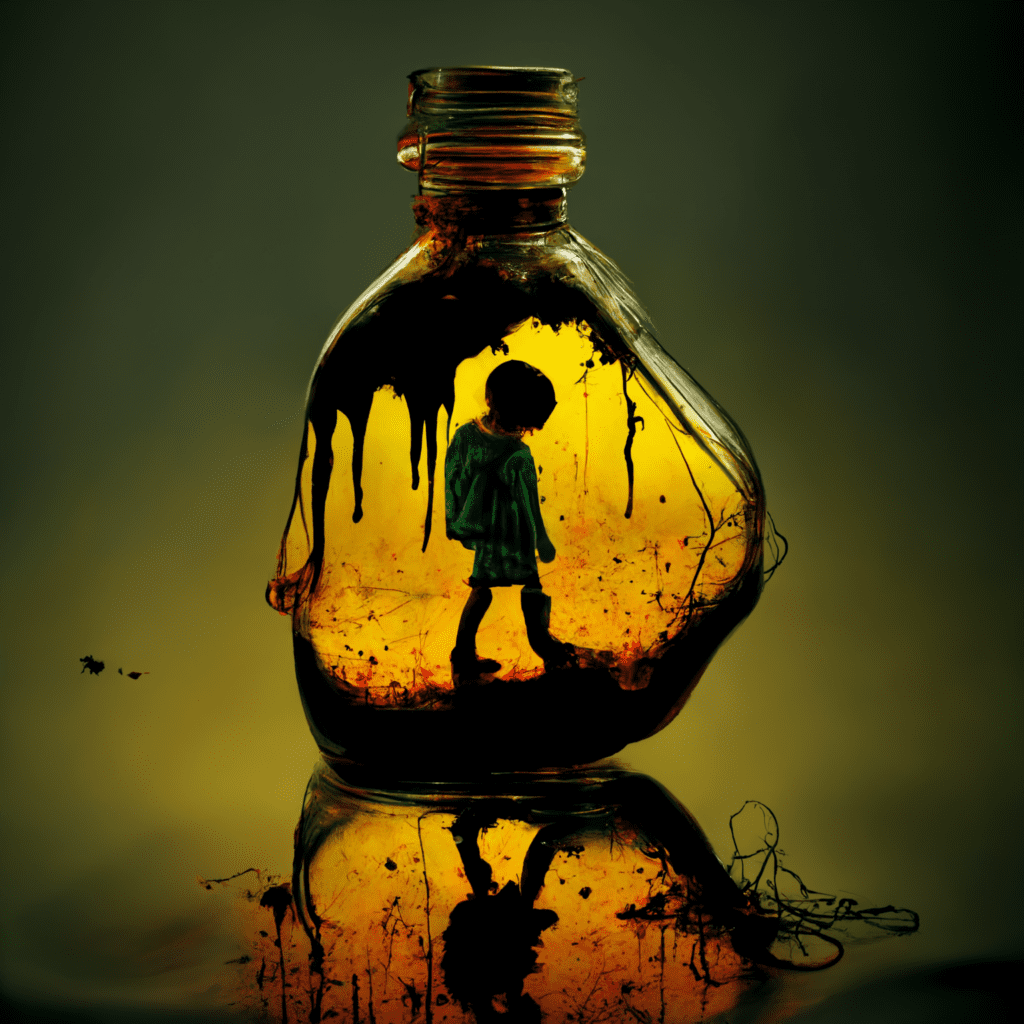Toxic shame – the facade of emotional flashbacks:
- Toxic shame – the facade of emotional flashbacks:
- I. Introduction.
- Defining toxic shame in cPTBS:
- Shame
- Toxic shame
- II. causes of toxic shame in cPTBS.
- Childhood trauma:
- Lack of self-care:
- The Inner Critic:
- III. Symptoms of Toxic Shame in cPTBS.
- Cognitive distortions:
- Black-and-white thinking
- Overgeneralization
- Catastrophizing
- Self-deprecation
- The link between toxic shame and rage:
- The link between toxic shame and psychosomatic complaints:
- Emotional dysregulation and psychosomatic complaints
- Relationship problems:
- How can partners still help?
- IV. Strategies for overcoming toxic shame in cPTSD.
- Identification of triggers:
- Mentalisation and self-compassion:
- Mentalisation
- Self-compassion
- Mindfulness exercises and self-care practices:
- Self-care
- Self-reflection
- Mindfulness
- Strategies for regulating rage:
- V. Conclusion.
- Summary of key points:
- Treatment options for toxic shame in cPTBS:
Toxic shame can rightly be seen as a facade for emotional flashbacks. Emotional flashbacks are a core feature of cPTSD, constantly occurring and accompanied by intense fear, shame, and inadequacy. Toxic shame will cause the sufferer to feel guilty and ashamed during an emotional flashback, even if there is no apparent trigger. In these cases, toxic shame can paradoxically serve as a protective mechanism that allows sufferers to control their emotions and avoid feeling helpless in a traumatic situation.
I. Introduction.
Defining toxic shame in cPTBS:
Toxic shame is a constant companion for Complex Post-Traumatic Stress Disorder survivors (cPTSD). This article explores toxic shame’s causes, symptoms, and treatment options in cPTBS.
Shame
Shame is generally a form of reaction to the experience of being exposed, guilty, having failed, losing prestige or the like, often accompanied by vegetative symptoms such as blushing and palpitations. The experience of shame is an uncomfortable feeling with a loss of affirmative relationship with oneself, fellow human beings and the world. The shame of the body must be separated from the shame of the soul. The latter is an unpleasant emotional experience that occurs when someone believes they have violated their own or social norms or moral standards. It can be experienced as a sense of personal defeat or inadequacy, and is typically accompanied by a dent in self-respect and self-esteem.
Toxic shame
Toxic shame is a form of shame that becomes deeply embedded in the personality and creates a lasting sense of inferiority and guilt. It does not refer to actions, thoughts, or feelings but to the self of the person affected. Unlike “healthy” shame, which encourages us to change our behaviour, toxic shame causes us to experience ourselves as inferior, unlovable, and unworthy. This toxic shame arises from traumatic childhood experiences, such as abuse or neglect, and can lead to emotional dysregulation.
The main difference between shame and toxic shame is the intensity and permanence of the experience. Situational shame is temporary and encourages us to question and work on ourselves. On the other hand, toxic shame is deeply rooted and impacts us throughout our lives. Toxic shame, therefore, also leads to unhealthy coping strategies (SDCS), such as addictive behaviour or self-harm, to suppress the feeling of shame.
II. causes of toxic shame in cPTBS.
Childhood trauma:
Toxic shame arises from the traumatic childhood experiences of sufferers. These traumas can be physical (sexual), emotional or spiritual and are caused by violence, abuse, or neglect. They force children to internalize the feeling that they are to blame for the traumatic events.
Thus, children or adolescents growing up in dysfunctional families were often criticized, rejected, ridiculed, or even punished when they expressed their needs and feelings. This constant negative validation makes them feel guilty and ashamed of everything they do or don’t do, say, or don’t say, think or feel.
Toxic shame can also be generated by sexual abuse or other forms of violence that violate body boundaries and leave sufferers with a deep sense of defilement. The experience of sexual abuse or rape frequently makes the child feel ashamed of what happened and blame themselves. That can make victims feel uncomfortable or awkward in their bodies and judge themselves for the experience.
Of course, traumatic events in adulthood can also trigger shame. For example, if a person is in a situation where they become the victim of violence or abuse, this can lead to a feeling of guilt that they could not protect themselves or prevent it from happening. Even if the victim is not to blame for the event, she may feel guilty and ashamed.
In none of the cases is a toxic shame the victim’s fault, and instead, it arises as a natural reaction to traumatic experiences that violate the victim’s dignity and integrity. However, it is also essential to understand that toxic shame can typically lead to the victim continuing to feel guilty and ashamed even after the traumatic events have long passed.
Lack of self-care:
Lack of self-care because of the feelings of guilt just mentioned can be an important cause of toxic shame in the later life of trauma survivors. Those who rarely experience that their needs have been reliably and caringly met will develop difficulties caring for and accepting themselves. Instead, harsh self-criticism will lead to neglect of one’s needs and a sense of inadequacy. A vicious circle starts when sufferers feel they are neither entitled nor able to self-care, and therefore end up in situations that further undermine their self-esteem. Consequently, they find themselves in unhealthy relationships or situations again and again.
So, people with toxic shame often struggle to stand up for themselves or set boundaries. They feel guilty or inferior for standing up for their needs and are, therefore, usually willing to put their wants and needs aside to meet the needs of others.
The Inner Critic:
The Inner Critic of trauma survivors is a part of the psychological self that tends to engage in mean negative self-talk, harming self-esteem. It is a form of the superego gone wild. Instead of providing values and principles to judge and guide our behaviour, it becomes a punishing and persecuting entity that dominates the entire inner life and leaves no room for the ego to breathe. Its connection to toxic shame is complicated. On the one hand, the Inner Critic can trigger toxic shame but is also triggered or reinforced by toxic shame.
The Inner Critic ensures that sufferers set high standards for themselves and berates them relentlessly when they do not meet them. In doing so, they constantly feel that they are not good enough or do not deserve to take good care of themselves.
Toxic shame, in turn, can cause the Inner Critic to trigger more negative self-talk that further affects self-esteem. The sufferer may condemn themselves for faults or weaknesses. The Inner Critic may, at the same time, also cause sufferers to downplay their successes or strengths or cast doubt on them, contributing to a feeling of being overwhelmed by guilt. Affected persons then suppress or avoid their emotions, which can aggravate toxic shame and even psychosomatic complaints.
III. Symptoms of Toxic Shame in cPTBS.
Toxic shame manifests itself in various ways, but there are some common symptoms that many people with cPTSD may experience. These symptoms include:
- A feeling of inadequacy and worthlessness is often accompanied by beliefs that one does not deserve to be happy or receive love and support. These beliefs can make the sufferer feel uncomfortable and insecure in social situations and isolate themselves from others.
- An intense fear of rejection and judgement from other people. Affected people will also feel uncomfortable in social situations and doubt whether she is valuable enough to be accepted by others. This fear may cause the affected person to withdraw from social situations or over-adapt to avoid rejection and criticism.
- Another consequence of toxic shame is the feeling that one cannot be authentic for fear of being despised. The sufferer may feel compelled to conform or pretend to avoid being criticized or rejected by others. Alienation and loneliness are possible consequences.
- A lack of self-confidence and self-esteem. Affected people devalue themselves and question their abilities and achievements. This can even lead to sufferers sabotaging themselves and avoiding opportunities and possibilities that could improve their lives.
- — A high level of self-criticism and self-judgement that can lead to self-harm or even suicide. Those who see themselves as worthless and unloved are prone to severe depression and anxiety.
Cognitive distortions:
People with cPTSD who suffer from toxic shame tend to maintain cognitive distortions. Cognitive distortions are patterns of thinking that can interfere with the perception of reality and increase negative emotions. Several cognitive distortions are frequent in cPTSD, including black-and-white thinking, overgeneralization, catastrophizing and personal devaluation.
Black-and-white thinking
Black-and-white thinking categorizes everything into “good” or “bad” and does not allow for any grey area. That can lead to people devaluing their achievements and successes and feeling inferior because they are not perfect.
Overgeneralization
Overgeneralization occurs when one negative experience leads one to believe that all future experiences will be equally harmful. That tragically feels as if nothing will ever change, or even change for the better. It results in deep hopelessness and resignation because the person believes they will never be able to improve or have positive experiences.
Catastrophizing
Catastrophizing is constantly assuming the worst everywhere, even without an objective reason. This results in hypervigilance and heightened alertness, increasing fear and panic in certain situations. Catastrophizing prevents sufferers from having new experiences or taking risks.
Self-deprecation
Self-deprecation is the direct effect of toxic shame on the sufferer’s self-esteem, and it also prevents the person from realizing their potential or using their strengths.
Overall, people with toxic shame often engage in negative self-talk, maintaining cognitive distortions that reinforce feelings of shame.
The link between toxic shame and rage:
Rage can be a natural reaction to trauma, but toxic shame can make the trauma survivor feel inappropriately guilty and suppress their anger.
When sufferers cannot express their rage, it builds up in the body and manifests in physical symptoms such as headaches, stomach problems or sleep disturbances. Sufferers may also deal with their anger in unhealthy ways (SDCS) by suppressing it through alcohol abuse, drug use or other self-destructive behaviours.
Therefore, healthily expressing rage can be an essential step in the growth process. Those who express anger can also reduce their feelings of shame and regain a sense of control and self-respect. Anger can help set boundaries and protect the person from further trauma.
Therefore, therapy aimed at regulating rage must help develop healthy coping strategies and express anger appropriately. In addition, physical activities such as sports or creative practices such as painting or writing can help to healthily channel anger (s. below).
The link between toxic shame and psychosomatic complaints:
It has already been mentioned: Toxic shame can also play a role in psychosomatic complaints, significantly when emotions are repressed and not mentalized. (Psychosomatic complaints are physical symptoms triggered by emotional or psychological factors).
Then the repressed emotions can be expressed in physical symptoms: Headache, stomachache or back pain. Psychosomatic complaints, however, are not imaginary but are actual physical symptoms that need to be treated. Therapy that focuses on regulating emotions and mentalization can help reduce psychosomatic complaints and strengthen self-esteem.
Emotional dysregulation and psychosomatic complaints
Toxic shame and emotional dysregulation are closely related and can occur in numerous instances. Emotional dysregulation occurs when a sufferer is overwhelmed by their emotions, and affected persons glide into either overexcitement or paralysis (dissociation). Toxic shame can trigger or exacerbate emotional dysregulation by altering self-esteem and self-perception. In addition to feeling overwhelmed or hopeless, sufferers feel ashamed that they cannot adequately regulate their emotions.
Furthermore, the reaction to traumatic memories or emotional triggers can, in turn, increase feelings of shame. A vicious cycle follows, in which emotional dysregulation and toxic shame reinforce each other, keeping the sufferer in turmoil and despair.
Relationship problems:
Considering the consequences and symptoms, it is unsurprising that toxic shame also significantly harms relationships. People suffering from Toxic shame often self-harm and avoid entering intimate relationships for fear of rejection and judgement. Distrust and difficulty opening up to others and building trust typically lead to their relationships remaining superficial or even failing.
Toxic shame can also lead to the person finding themselves in unhealthy relationships where they are criticized or emotionally abused, which increases their shame and further undermines their self-esteem (repetition compulsion).
In a sustainable relationship, overcoming toxic shame is a collaborative process. However, partners must communicate their needs and boundaries in the process and ensure the relationship does not become one-sided support.
How can partners still help?
Partners can help in many ways when their partner is suffering from toxic shame. One important aspect is to create a supportive atmosphere in which the person feels safe to express their feelings and needs. To this end, it can be helpful to have an open and understanding ear and to be attentive when the affected person talks about their feelings of shame.
Feelings of shame are often deeply rooted; overcoming them can take time and support. It is, therefore, crucial for partners to engage in the process and not put pressure on themselves or their partners.
Another way partners can help is by encouraging self-care. By supporting their partner in caring for themselves, they can help build self-esteem and develop self-awareness. This can be achieved through joint activities such as yoga or meditation, healthy eating and getting enough sleep. These seemingly “harmless” everyday activities are critical when sexuality in the relationship – due to their negative self-image – is experienced as highly shameful by sufferers.
Overall, partners can help support affected persons in not projecting their feelings of shame onto themselves and expressing them. By communicating their needs and boundaries and ensuring that the relationship does not become too one-sided, partners can help build a healthy and balanced relationship. Open communication is, therefore, essential. If necessary, support from a therapist or counsellor may also be required.
IV. Strategies for overcoming toxic shame in cPTSD.
Overcoming toxic shame in cPTSD requires time, patience, and a willingness to engage in the growth process. No quick fix or magic pill can instantly eliminate toxic shame. Treatment of cPTSD requires a comprehensive approach. It is not simply a matter of working through traumatic experiences, but primarily of overcoming self-harming coping strategies and building a positive, fair self-image.
In addition, self-care practices that include regular physical activity, healthy eating, getting enough sleep and avoiding self-sabotage behaviours can also help overcome toxic shame.
Journaling is an essential component because it allows for examining negative beliefs and deepening corrective experiences and successes.
Identification of triggers:
Triggers for toxic shame can arise from different situations or experiences. They can come from outside, such as comments or evaluations from others, or from within, such as memories of past experiences or even dreams. It is essential to recognise and, if possible, avoid triggers for toxic shame to reduce feelings of guilt and strengthen self-esteem.
Sufferers can list situations or events that trigger toxic shame from the journal. This list can help identify the triggers for toxic shame and develop strategies to avoid or counter them.
In many cases, therapeutic support can also help identify triggers for toxic shame and develop coping strategies. Therapy focusing on emotion regulation and mentalisation can help reduce triggers for toxic shame and strengthen self-esteem.
Mentalisation and self-compassion:
Mentalisation and self-compassion can be essential factors in overcoming toxic shame in CPTSD.
Mentalisation
Mentalisation is the ability to recognise, understand and interpret our thoughts and feelings as well as the thoughts and feelings of others. It is the basis for identifying and neutralising our negative thought patterns and self-talk that can lead to feelings of shame. By developing more vital mentalising skills, affected people can better understand their guilt and identify the sources of their shame to work on them in a targeted way. Those who feel more confident to assess the feelings of others realistically are also less likely to be plagued by social anxiety.
Self-compassion
Self-compassion builds on successful mentalising and is the ability to relate to ourselves in the same way we would to a close friend. It involves the ability to accept ourselves, despite our imperfections and flaws. Self-compassion can help neutralise negative self-talk and the Inner Critic by allowing us to be kinder and more compassionate towards ourselves.
Together, mentalising and self-compassion can help reduce negative feelings of shame and boost self-esteem. By recognising and interpreting their thoughts and feelings, sufferers can better understand and target their negative self-talk. By learning to treat themselves with compassion and kindness, they can neutralise their feelings of shame and strengthen their self-esteem.
There are many ways to develop mentalisation and self-compassion. These include developing a positive and supportive Inner Voice that emphasises the importance of self-compassion and encourages people to be kinder and more compassionate towards themselves.
Mindfulness exercises and self-care practices:
Self-care
Healthy self-care can help boost self-esteem and reduce negative feelings of shame. It can also help sufferers build healthy relationships and put themselves in situations that boost their self-esteem. However, survivors must permit themselves to feel cared for and supported in the first place. Self-compassion and self-acceptance can help strengthen self-esteem and reduce negative feelings of shame. People can give themselves positive affirmations or remind themselves of past successes or positive qualities to boost their self-esteem.
There are many ways to practice self-care, including meditation, yoga, walks in nature or bodywork.
It can also mean time alone to reflect and mentalise one’s thoughts and feelings. The sufferer can also learn to express their needs and set healthy boundaries to strengthen self-care.
Self-reflection
Limiting the Inner Critic is as vital as it is difficult. By working on toxic shame and developing self-compassion and self-acceptance, the Inner Critic’s negative self-talk needs to be reduced.
The mindfulness and self-reflection mentioned earlier help to cut back the Inner Critic. Sufferers must learn to recognise and challenge negative self-talk to develop a healthier self-perception.
Mindfulness
Another strategy is to practice mindfulness and learn to observe one’s thoughts and feelings to recognise negative self-talk or shame early on and stop it quickly (thought stopping).
Self-care practices to strengthen the mind-body connection.
It is essential to realise that self-care is not a selfish or unnecessary act but a necessary component of health and well-being. It also requires a conscious effort to recognise and reduce negative self-talk and downsize the Inner Critic. Developing a positive and supportive Inner Voice that emphasises the importance of self-care and encourages the survivors to care for themselves can be helpful.
Overall, toxic shame can cause sufferers to have difficulty caring for themselves because their Inner Critic tells them they don’t deserve it or that it is selfish to care for themselves. It is essential to realise that self-care is necessary to promote health and well-being and requires a conscious effort to neutralise negative self-talk and the Inner Critic.
Strategies for regulating rage:
People with Toxic Shame associated with cPTSD often have difficulty managing their anger. That is because, as children – for their protection and – they had to learn to suppress their rage to such an extent that they no longer have access to their aggressive impulses (4 F‘s). However, suppressing anger will also lead to excessive emotional distress and worsening symptoms.
Finding a healthy way to deal with, and express anger is crucial. It is essential to learn to recognise rage and identify its source, which can help avoid inappropriate or uncontrolled fits of anger.
At the same time, it will also help create a supportive environment to express anger without being judged or punished.
Another way to deal with anger is to redirect it into constructive actions. For example, you can use your rage to change your life or society positively. It can also be helpful to engage in physical activities such as sports or yoga to release the energy created by anger. Yelling, punching a pillow, or even a punching bag or an old phone book to tear up may become necessary to avoid indiscriminately destroying objects and feeling deeply ashamed and guilty again.
A therapist can also help find healthy ways to deal with anger and redirect it into constructive action.

V. Conclusion.
Summary of key points:
Toxic shame is a common symptom of cPTSD and has a devastating impact on sufferers’ self-esteem and emotional life: relationship problems, psychosomatic complaints or the development of unhealthy coping strategies are the consequences.
However, it is possible to overcome toxic shame and strengthen self-esteem. A comprehensive approach that includes both emotional and cognitive aspects can help to enhance self-esteem and improve the regulation of emotions.
Identifying triggers for toxic shame and developing coping strategies can help reduce triggers for shame and strengthen self-esteem. Therapy that focuses on emotion regulation and mentalisation helps to overcome negative feelings of guilt and reinforces self-esteem.
Treatment options for toxic shame in cPTBS:
Treatment for toxic shame in cPTSD usually requires a comprehensive approach that includes psychotherapy and medication. Some of the treatment options include:
- Psychotherapy: working with an experienced therapist can help understand the causes of toxic shame and relieve symptoms. Some effective therapies are trauma-focused psychodynamic therapy, cognitive behavioural therapy, dialectical behavioural therapy and sometimes EMDR (Eye Movement Desensitization and Reprocessing).
- Medications: In some cases, antidepressants or anti-anxiety medications may be prescribed to relieve the symptoms of toxic shame.
- Self-care: People with cPTSD who suffer from toxic shame must take care of themselves and make time for self-care regularly.
Overcoming toxic shame is an individual process that requires patience and time. However, with the proper support and a comprehensive approach, people with cPTSD can learn to reduce their feelings of shame and live their lives more positively.
Sources:
Walker, P. (2013). Complex PTSD: From Surviving to Thriving: A Guide and Map for Recovering from Childhood Trauma. CreateSpace.
Walker, P. (2015). The Tao of Fully Feeling: Harvesting Forgiveness Out of Blame. Createspace Independent Publishing Platform.





